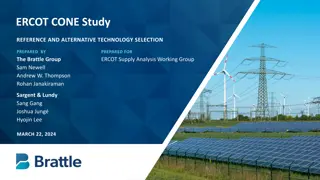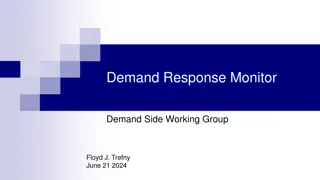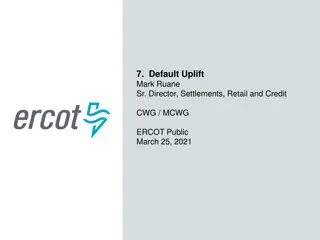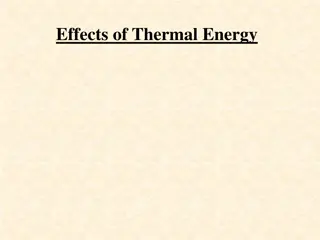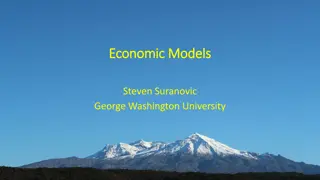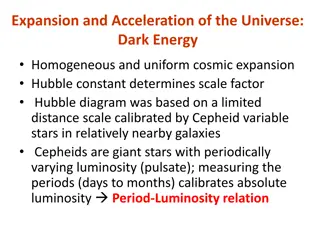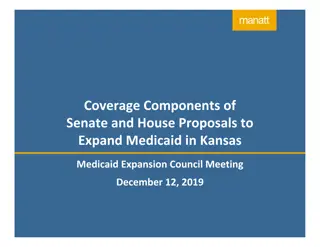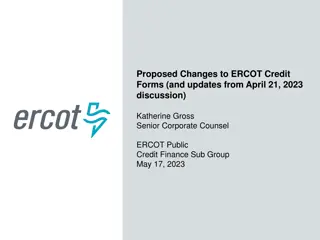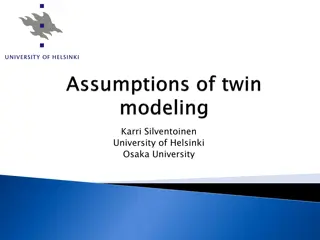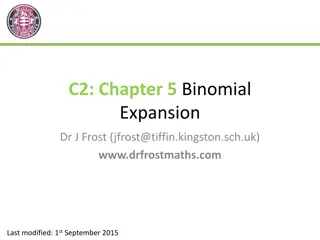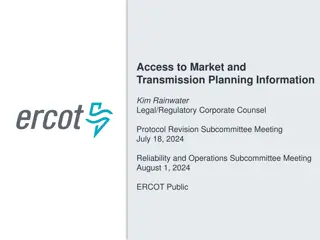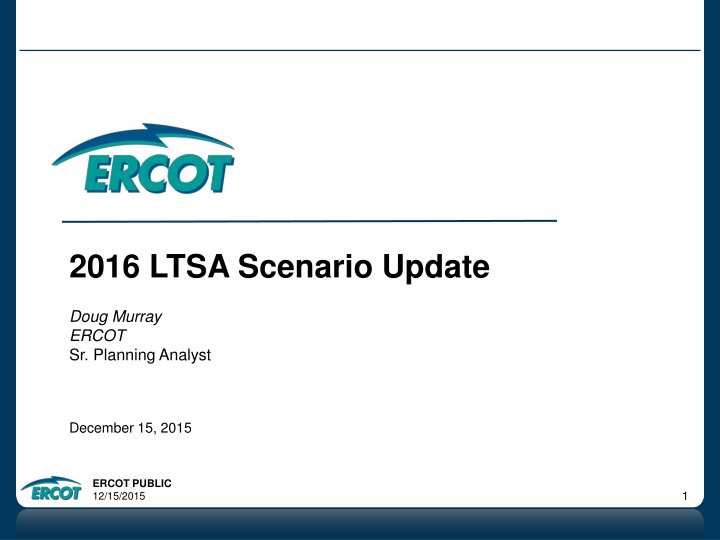
ERCOT 2016 LTSA Scenario Update by Doug Murray: Key Assumptions and Expansion Plans
This update provides detailed information on standard and specific scenario assumptions for the ERCOT energy market, including capacity installations, demand projections, economic growth factors, environmental mandates, and the schedule for generation expansion. The document outlines critical variables impacting future energy planning and outlines key milestones in the expansion process.
Download Presentation

Please find below an Image/Link to download the presentation.
The content on the website is provided AS IS for your information and personal use only. It may not be sold, licensed, or shared on other websites without obtaining consent from the author. If you encounter any issues during the download, it is possible that the publisher has removed the file from their server.
You are allowed to download the files provided on this website for personal or commercial use, subject to the condition that they are used lawfully. All files are the property of their respective owners.
The content on the website is provided AS IS for your information and personal use only. It may not be sold, licensed, or shared on other websites without obtaining consent from the author.
E N D
Presentation Transcript
2016 LTSA Scenario Update Doug Murray ERCOT Sr. Planning Analyst December 15, 2015 ERCOT PUBLIC 12/15/2015 1
Standard Scenario Assumptions All scenarios will include: 700 MWs of load for LNG Facilities Fixed capacity retirements of 17,499 MWs by 2031 CSAPR and Regional Haze emission costs Costs for CSAPR emissions SO2 - $10/ton Annual NOx - $100/ton Seasonal NOx - $200/ton Regional Haze adders to fixed costs for units needing physical improvements to plants Retrofit cost - $500/kW, 5 years after final rule Upgrade cost - $500/kW, 3 years after final rule Generation expansion will be run from 2017 thru 2031 ERCOT PUBLIC 12/15/2015 2
Standard Scenario Assumptions All scenarios will include: 5,888 MWs of capacity installed after 1/1/2016 Wind 4,031 MWs Solar 707 MWs Internal Combustion 276 Combustion Turbine 874 ERCOT PUBLIC 12/15/2015 3
Specific Scenario Assumptions Current Trends 3.5% of total demand met by EE additions in 2031 2031 peak 81,949 MWs 5% of premises with rooftop solar growing at 20%/year Additional 683 MWs by 2031 High Economic Growth Based on Moody s high economic data 2031 peak 83,419 MWs High NG price (see appendix) 3.5% of total demand met by EE additions in 2031 13.75% reserve margin requirement Additional 600 MWs of LNG added in Brownsville 300 MWs in 2020 450 MWs in 2021 600 MWs in 2022 ERCOT PUBLIC 12/15/2015 4
Specific Scenario Assumptions Environmental Mandate PTC/ITC 7% of total demand met by EE additions in 2031 2031 peak 79,116 MWs CO2 price included Range from $5 to $50 Increase to NOx and SO2 prices Additional 1,500 MW DC tie capacity 10% of premises with rooftop solar growing at 25%/year Additional 1,348 MWs by 2031 ERCOT PUBLIC 12/15/2015 5
Schedule for Generation Expansion Running Current Trends Scenario now Completion of generation expansion January/February 2016 Scenario Not Started In Process Completed Current Trends High Economic Growth Environmental Mandate Texas Recession Extended Extreme Weather High Energy Efficiency/Ditributed Generation Sustained Low Natural Gas Price Storage/Electric Vehicle Adoption ERCOT PUBLIC 12/15/2015 6
Questions Contact info: Doug Murray douglas.murray@ercot.com 512.248.6908 Julie Jin julie.jin@ercot.com 512.248.3982 Sandeep Borkar sandeep.borkar@ercot.com 512.248.6642 ERCOT PUBLIC 12/15/2015 7
Appendix ERCOT PUBLIC 12/15/2015 8
Capacity Installed after 1/1/2016 Unit Capacity Fuel Data Unit Capacity Fuel Data SKY GLOBAL POWER ONE 51 NG 1/1/2016 MAGIC VALLEY WIND II (REDFISH 2B) 115 WND 12/1/2016 ECTOR COUNTY ENERGY CTG 1 170 NG 1/1/2016 ROCK SPRINGS VAL VERDE WIND 180 WND 12/1/2016 ECTOR COUNTY ENERGY CTG 2 170 NG 1/1/2016 DOUG COLBECK'S CORNER (CONWAY) 200 WND 12/1/2016 BAFFIN WIND [BAFFIN_UNIT1-2] 202 WND 1/1/2016 SWISHER WIND 300 WND 12/1/2016 FS BARILLA SOLAR 1B (HOVEY_UNIT2) 7.4 SUN 1/1/2016 BUCKTHORN WIND 1 96 WND 12/1/2016 SOUTH PLAINS WIND III 150 WND 5/31/2016 HAPPY WHITEFACE WIND 157 WND 12/1/2016 OCI ALAMO 6 (WEST TEXAS) 110 SUN 6/1/2016 HIDALGO & STARR WIND 250 WND 12/1/2016 ELK STATION CTG 2 (SWITCHABLE) 197 NG 6/1/2016 BLANCO CANYON WIND (COTTON PLAINS) 50 WND 12/1/2016 ELK STATION CTG 3 197 NG 6/1/2016 BLANCO CANYON WIND (OLD SETTLER) 150 WND 12/1/2016 RE ROSEROCK SOLAR 150 SUN 7/1/2016 CHAPMAN RANCH WIND I 250 WND 12/1/2016 RED GATE IC PLANT A 56.25 NG 7/31/2016 RTS WIND 200 WND 12/1/2016 RED GATE IC PLANT B 56.25 NG 7/31/2016 SAND BLUFF WIND 90 WND 12/1/2016 RED GATE IC PLANT C 56.25 NG 7/31/2016 UPCO POWER 1 (SP-TX-12) 180 SUN 12/1/2016 RED GATE IC PLANT D 56.25 NG 7/31/2016 GRANDVIEW WIND 3 (CONWAY) 188 WND 12/15/2016 GUNSIGHT MOUNTAIN WIND 120 WND 8/1/2016 TORRECILLAS WIND A 200 WND 12/31/2016 OCI ALAMO 7 (PAINT CREEK) 110 SUN 8/1/2016 TORRECILLAS WIND B 200 WND 12/31/2016 LOS VIENTOS IV WIND 200 WND 9/1/2016 LONGHORN WIND SOUTH 160 WND 12/31/2016 ELECTRA WIND 360 WND 10/1/2016 SOUTH PLAINS WIND 2 98 WND 12/31/2016 SE BUCKTHORN WESTEX SOLAR (OAK) 150 SUN 10/15/2016 Freeport LNG Pre Treatment 11 NG 6/1/2017 MAGIC VALLEY WIND II (REDFISH 2A) 115 WND 12/1/2016 FRIENDSWOOD G 129 NG 6/1/2017 ERCOT PUBLIC 12/15/2015 9
Base Capital Cost Assumptions ($/kW) Thermal plant costs increase at 2.4% annually (2015 EIA AEO) Year 2014 2015 2016 2017 2018 2019 2020 2021 2022 2023 2024 2025 2026 2027 2028 2029 2030 2031 CC 1,073 1,099 1,125 1,152 1,180 1,208 1,237 1,267 1,297 1,328 1,360 1,393 1,426 1,461 1,496 1,532 1,568 1,606 CT 791 810 829 849 869 890 911 933 956 979 1,002 1,026 1,051 1,076 1,102 1,128 1,155 1,182 Coal 3,202 3,279 3,357 3,438 3,520 3,605 3,691 3,780 3,871 3,964 4,059 4,156 4,256 4,358 4,463 4,570 4,679 4,792 Nuclear 6,395 6,548 6,705 6,866 7,031 7,200 7,372 7,549 7,731 7,916 8,106 8,301 8,500 8,704 8,913 9,127 9,346 9,570 IGCC 4,307 4,410 4,516 4,624 4,735 4,849 4,965 5,085 5,207 5,332 5,460 5,591 5,725 5,862 6,003 6,147 6,294 6,446 Wind 1,800 1,782 1,764 1,747 1,729 1,712 1,703 1,695 1,686 1,678 1,669 1,661 1,665 1,669 1,674 1,678 1,682 1,686 Solar PV Biomass Geothermal Battery 2,160 3,903 1,824 3,997 1,616 4,093 1,452 4,191 1,365 4,292 1,341 4,395 1,325 4,500 1,310 4,608 1,298 4,719 1,294 4,832 1,298 4,948 1,304 5,067 1,311 5,189 1,317 5,313 1,324 5,441 1,330 5,571 1,337 5,705 1,344 5,842 CAES 1,056 1,076 1,095 1,116 1,136 1,157 1,178 1,200 1,222 1,244 1,267 1,291 1,314 1,338 1,363 1,388 1,414 1,439 5,025 5,145 5,269 5,395 5,525 5,657 5,793 5,932 6,074 6,220 6,369 6,522 6,679 6,839 7,003 7,171 7,344 7,520 750 735 710 680 632 611 590 585 580 576 587 598 609 620 631 643 655 667 ERCOT PUBLIC 12/15/2015 10
Natural Gas Price Assumptions Average of EIA Reference and EIA High Oil & Gas production case will be used for Current Trends Scenario For Low Natural Gas Price Scenario assumed price remained below $4/mmBtu ERCOT PUBLIC 12/15/2015 11
The 2016 LTSA Scenarios 1. Current trends 2. High economic growth 3. Environmental mandate 4. Texas recession 5. Extended extreme weather 6. High energy efficiency/distributed generation 7. Sustained low natural gas scenarios 8. Storage/electric vehicle adoption scenario ERCOT PUBLIC 12/15/2015 12
1. Scenario: Current trends Technology No breakthroughs steady modest cost improvements New DC ties Economic Growth Migration to TX along I-35 corridor Lower Growth in south and west Texas Industrial growth in Houston, I-35 Average GDP growth in line with long-term average US GDP growth rate~1.5% load growth high growth in near term then tapering off in long-term LNG growth based on permits existing may be 2 new LNG plants Oil production rates drop to those seen in recent projections Story: Same old, same old. The recent population and economic growth in Texas continues in the near future, however the recent decline of the oil and gas sector has impacted growth in the west and south Texas especially in areas near the oil and gas plays. World oil prices are low enough to keep oil production low in the short-term, while also keeping domestic natural gas prices relatively low. With low gas prices, currently commissioned LNG export terminals get completed by 2019-2020 timeframe however no new LNG Terminals get added. Modest wind and solar growth continues based on economics without production tax credits. Capital costs for solar continues to decline at the current rate for 3-4 more years. No required reserve margin is set for ERCOT and the environmental regulations continues to be moderate, with no explicit federal carbon tax. However SOx/NOx limits imposed by CSPAR, and Regional Haze ruling become active by 2018. Government policy/mandate No reserve margin set for ERCOT Maintain energy-only market Economic retirements continues based on economics Increased DC-tie capacity with neighboring region Environmental Regulation Impact of Regional HAZE and CSAPR are seen in the near future CSAPR Hybrid Greenhouse gas regulation set with flexibility No other major changes in environmental regulations no CPP impacts End-Use Increased need for ancillary services Increase penetration of demand response Increasing distributed generation Alternative Generation Total wind capacity of 20K to 25K generation added by 2017 Solar capability addition limit:1000 MW/ year Wind capacity addition limit: 3,000 MW/yr Capacity factor wind rely on historical data from ERCOT Capital cost wind ~$1755/kW Capital cost solar ~4.4% reduction/year continues for 3 to 4 years Overall renewable growth driven by economic entry No production tax credit beyond 2013 No change to existing investment tax credit policy Implications for ERCOT: Continued modest economic and therefore load growth in Texas. Reduction in oil production and population across the state results in slower load growth in oil and gas producing regions Continued increased renewables especially solar may lead to reliability (inertia) issues While EPA s clean power plan has not been implemented in this scenario, other emissions standards may have some effect on future generation mix Weather / Water No drought situation, but water supply continues to be a concern to existing and new generators. No specific increase in electricity consumption due to drought conditions. Gas/Oil Prices Sustained low oil prices Moderate growth in natural gas prices ERCOT PUBLIC 12/15/2015 13
2. Scenario: High economic growth Technology Smarter appliances with an increase in efficiency and price responsive Automated price responsive demand response is greater than Current Trends Economic Conditions High Texas GSP growth ~5%/year High population growth (2.5%/yr) Pro-business environment Industrial growth concentrated in Houston, I-35 corridor, Midlands/Odessa, Lower Rio Grand Valley Higher LNG exports than under Current Trends Capital is available to support new generation and transmission Story: Texas economy continues to outpace US economic growth. Increased immigration to Texas shows continued accelerated load growth in urban centers. Higher natural gas prices increase drilling activity and lead to higher economic growth than under Current Trends. Growth occurs throughout Texas driven in large part by oil and gas sector and related upstream and downstream industries. Local natural gas price, while higher than current trends, is expected to be competitive in global LNG market, thus resulting completion of additional LNG terminals along the Texas gulf coast. Lastly, Alternative generation such as wind and solar is expected to respond to higher priced natural gas fueled generation. Gen Resource Adequacy Standards mandated reserve margin of 13.75% Consider additional ancillary services Environ. Regs/Energy Policy Continued modest environmental regulations, no significant changes from assumptions under Current Trends U.S. more focused on developing domestic energy sources End-Use Growth of household income however, more energy-efficient new homes Overall efficiency gains are similar as under Current Trends Higher distributed generation than current trends Alt. Gen. Resources Renewables are economic and growth occurs due to higher gas prices More technological improvement than under Current Trends for renewables and storage Cap on annual wind capacity growth Implications for ERCOT: High load growth High urban growth High industrial growth, concentrated through I-35 corridor, Midlands/Odessa, Lower Rio Grand Valley and oil and gas rich areas Potential challenges with generation portfolios keeping pace with load profile changes Weather / Water Same as Current Trends Oil/Gas Prices Higher (but still relatively low) gas prices than under Current Trends (~$6/7 or use EIA s high forecast) Higher oil prices than under Current Trends ERCOT PUBLIC 12/15/2015 14
3. Scenario: Environmental mandate Natural Gas Prices Same as Current Trends Same amount of LNG exports as under Current Trends Economic Conditions Moderate economic growth Same LNG exports than under Current Trends Population growth same as under Current Trends Increase in industrial production of alternative energy and efficiency-related technologies Story: This scenario assumes a nationwide implementation of stringent environmental regulations. This implementation results in increased energy efficiency and customer-sited solar PV. In addition to the target of 32% CO2 reductions in Texas, the scenario also expects existing regulations related to Regional Haze, NAAQS and CSAPR continue to remain active. Continued drop in cost of renewable generation and retention of tax credits makes solar and wind generation more competitive. Stricter emission standards are expected to be in place to achieve the CO2 target set by these regulations, making coal generation less economical and may gradually get replaced by Natural Gas fired generation. Stricter regulations around water use result in installation of dry cooled generation. Technology Same as current trends Some improvement in efficiency of gas and renewable incorporation of storage. Transmission Regs Same as Current Trends Environmental Regs / Energy Policies Ongoing Regional Haze and CSAPR related emission limits remain active Carbon limits imposed by CPP implementation in Texas End Use Customers / Policies Continued stringent building code 10% improvement every 3 years Implications for ERCOT: Lower peak and overall end use Challenge in matching generator w/ load Reserve & integrate issues Potential need for new ancillary services to provide faster & flexible resources Alt. Generation Resources Continued PTC/ITC through 2020, reducing over time Continued decrease capital costs for solar: 3-5% /yr Wind capacity factors increase due to technological improvements Cap on annual wind generation Increased development of storage due to cost reductions for batteries & compressed air More financing mechanism are available; e.g.: real estate investment trusts, property-assessed clean energy financing, and others Weather & Water Same as Current Trends ERCOT PUBLIC 12/15/2015 15
4. Scenario: Texas recession Economic Conditions Net population growth in Texas ~negative to zero Urbanization with growth concentrated in the major cities No industrial growth Capital for new generation difficult to obtain Little to no GDP growth or net load growth Technology Less spending one energy efficient appliances Limited growth of new technologies that are still high costs, such as storage Story: Low energy prices threaten the Texas economy. Load growth is limited. Resource expansion is limited to gas- fired plants and continued subsidized renewables. Stimulus programs help create incentives for consumers to replace old appliances and increase conservation. similar to but less impactful than 1980 s recession. Environ. Regs. / Energy Policy Continuing modest environmental regulations, no significant changes from assumptions under Current Trends Government incentives continue for high efficiency appliances Same as Current Trends Gen Resource Adequacy Standards Retiring of coal plants due to low energy margins System inertia issues increase No reserve margin mandate Alt Gen Resources Lower oil/gas prices Limited development of wind and solar due to low energy prices Nuclear re-licensing Slower solar cost decline due to reduced global demand End - Use Customers are more cost conscious, thus more conservation less disposable income Implications for ERCOT: Slow load growth Growth in urban areas greater than in rural areas Counties with oil and gas economies shrink at a faster rate Limited generation development, predominantly gas-fired, subsidized renewables Import/export issues between urban areas will need to be addressed Stability issues continue to increase due to low system load Gas/Oil Prices Lower prices (~$1/mmbtu lower than assumptions under Current Trends) Less oil exploration and production No LNG development Weather / Water Same as under Current Trends no drought conditions, but limited water supply for new generation ERCOT PUBLIC 12/15/2015 16
5. Scenario: Extended extreme weather Technology More efficient appliances, HVAC Less water intensive generation Economic Conditions Slow down in population and economic growth with higher impacts on localities with water intensive industry Increased food, water and electricity prices Productivity and job losses in agriculture Potential negative impact on oil & gas extraction Impact on local economy, lower economic growth than national average Story: In this scenario Texas undergoes extreme weather conditions for an extended period of time, this means hot summers and cold winters. The sustained water stressed drought conditions impact water-intensive generation resources (nuclear/coal/steam units), and lead to significant increase in renewables and storage, dry cooling on thermal generation], and transmission expansion over those in Current Trends. Extremes in weather result in more energy consumption per capita. Gen Res Adequacy Standards Demand response plays a larger role than in Current Trends Increase in transmission due to policy/ regulatory changes resulting from drought Environmental Regs / Energy Policies Required drought management plans and water conservations Stringent requirements on power generation water use leads to dry cooling Tax breaks for drought resistant generation Other environmental regs are same as Current Trends End Use Customer / Policies Increase the development of demand- side management tools increases EE penetration beyond those in the Current Trends Greater market penetration of time- of-use rates and water smart devices Alt. Generation Resources Continued investments in renewables, storage, and dry-cooling Development of co-location desalination and power plants Renewable costs same as Current Trends Implications for ERCOT: Derating units due to water resource limitations and generation retirements lead to challenges in meeting demand Potential need for new ancillary services to meet the needs of integrating new renewable energy generation Seriously consider more interconnections outside ERCOT. Natural Gas and Oil Prices Moderate increase in natural gas prices relative to in Current Trends [$1 2/MMBtu] Moderate impact on local oil production, but prices are set internationally. at the same price as Current Trends Weather & Water More drought than in the Current Trends Extreme high and low temperatures Hot summers Limited water supply water rights restricted ERCOT PUBLIC 12/15/2015 17
6. Scenario: High efficiency/distributed generation Economic Same as under Current Trends Additional growth in clean technologies Technology Accelerated price reductions of solar, storage, high SEER HVAC, Lighting and Controls Story: Economic growth good enough to allow new investments in efficiency and distributed generation. Customers increase acceptance of EE/DG technologies which leads to widespread market adoption.In addition to the efficiency improvements there is higher participation in price responsive demand response. Gen Resource Adequacy Same as under Current Trends No reserve margin mandate however expectations is that increased load resources participation helps meet system need Environ. Regs/Energy Policy Increase stringency in building codes, with more net zero buildings Government provides more incentives for building retrofits to increase efficiency Increase in appliance standards increase More attractive DR programs/pricing Environmental regs same as current trends End Use More high efficiency homes and buildings built due to enhanced building codes Efficiency gains are above those under Current Trends, results in 30% reduction in energy usage in homes and buildings relative to pre-2006 Increased time of use + price- responsiveness Higher installation DG Higher DR participation More options for microgrids, smart appliances, etc. Alt. Gen. Resources Capital cost for wind and solar technologies and CHP decrease faster than under Current Trends Improved storage technology and lower cost Implications for ERCOT: Lower net load (demand and energy) growth compared to under Current Trends More market-based programs for demand response Widespread distributed generation creates some operational challenges Lower capital cost of renewable generation Gas Price / Oil Price Moderate to Higher gas prices (4$- 5$/mmbtu) than under Between Current Trends and High economic growth scenario: also higher resulting wholesale electricity prices Weather / Water Same as Current Trends ERCOT PUBLIC 12/15/2015 18
7. Scenario: Sustained low natural gas prices Story: Improvements in extraction technology continues to create an natural gas over- supply condition. As a result, gas prices continue to stay low in the 2- 4$/MMBtu range. Such sustained low natural gas prices creates an environment which stimulates growth in industrial sector. While the cost of local natural gas remains low, there continues to be a healthy global demand for US LNG, resulting in increase in development of LNG export terminals along Texas gulf coast Technology Efficiency improvements for gas plants and other generation types Economic Conditions Gas sector gets impacted with sustained load natural gas prices However, lower gas prices stimulates growth in manufacturing industry Global demand for US LNH continues to stay robust resulting an increase in development of LNG export terminals Resource Adequacy Standards As some plants become uneconomic, leading to pressure for market mechanisms Environmental Regulations Moderate regulation on oil & gas drilling activity Other environmental regulations are same as in Current Trends End - Use Less likely to have EE and DG growth Alternative Generation Slight slowdown on renewable roll out due to reduced NG prices PTC/ITC same as current trends Implications for ERCOT: The industrial sector sees strong growth Tighter reserve margin with unit retirements Seasonal mothballing of plants a possibility Need for transmission due to unit retirements and load growth in the industrial sector Natural Gas Prices Local natural gas priced stay low $2- 4/MMBtu . Global natural gas price continue to stay higher than US natural gas prices Weather / Water Same as Current Trends ERCOT PUBLIC 12/15/2015 19
8. Scenario: High storage/electric vehicle adoption Economic Conditions GDP growth same as Current Trends Population growth ~2.3%/yr Pro-business environment Story: Technology More spending on EE and energy storage More charging infrastructures Faster charging Longer range Electric Vehicles This scenario calls for increased adoption of Electric Vehicles and continued drop in the cost of . Storage. Electric vehicle developed for longer range, infrastructure for faster charging more prevalent. Proliferation of roof- top PV + Storage application results in flattening and shitting of loads. Electric vehicle charging has a potential of birthday cake effect showing spikes of demand during the shoulder hours. Environm. Regs/Energy Policy Modest environmental regulation, same as in under Current Trends Impact of Regional HAZE and CSAPR are seen in the near future Greenhouse gas regulation set with flexibility No other major changes in environmental regulations no CPP impacts Gen Res Adequacy Standards Same as under Current Trends No reserve mandate Implications for ERCOT: Flat load shape higher energy usage but net reduction and shifting of peak load and hour High urban growth due to growth in infrastructures used for electric vehicle charging and battery swapping centers More residential PV with storage End - Use Motivate high energy efficiency at a higher rate than current trends. Storage developed close to loads Flat load shape at the transmission delivery site More residential PV Alt. Gen Resources High penetration of storage coincident with higher penetration of wind and PV Renewable wind and solar growth same as current trends Weather / Water Same as under Current Trends Gas Prices / Oil Prices Same as Current Trends ERCOT PUBLIC 12/15/2015 20

